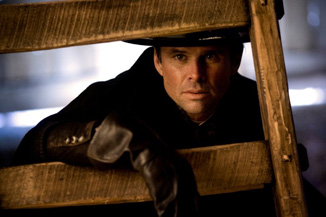|
|
Movie Review: The Hateful EightBy Ben GruchowJanuary 5, 2016
One of the movie’s best images is also one of its first: Samuel L. Jackson, sitting atop a pile of frozen bodies, waiting in the middle of a road as a stagecoach approaches. There’s a storm approaching, and when the stagecoach stops, Tarantino gives us a closeup on Jackson’s weathered face as he lifts his head to take notice. It has been a long, long time since photography this detailed, this evocative and atmospheric, has been put in the service of a storyteller that’s as visually bold as Tarantino is. Other moments in the film have a similar impact; most of the action takes place in a combination bar and inn called Minnie’s Haberdashery during a furious blizzard, and in the few wide shots we’re given when the action moves outside, the sense of depth and scope is startling. The story that takes place within these visuals is incongruously small and intimate. And mean-spirited, kind of, which is honestly pretty new in this director’s lexicon. The eight travelers snowbound in Minnie’s Haberdashery all have some kind of secret they’re concealing, to varying degrees. As the movie winds on and things get progressively consequential, we start to see the weather and its severity in a deterministic way. Our characters are here because they must be here, because it’s the only way their individual stories can come to any kind of conclusion. Tarantino has never been a filmmaker inclined to give his characters much in the way of free will, and the arrangement of the unfolding story in The Hateful Eight is immediately comprehensible as a series of pieces being moved around a board, into and out of position, by someone out of sight.
|

|
|
|

|
Thursday, October 31, 2024
© 2024 Box Office Prophets, a division of One Of Us, Inc.


